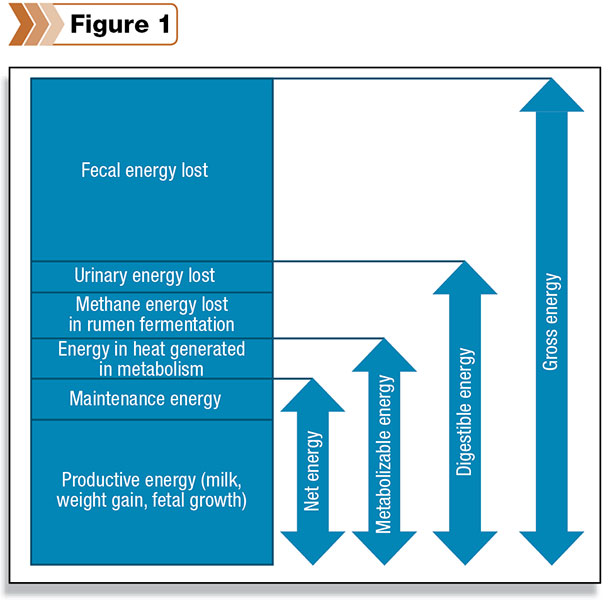GE, DE, ME, NEL, NEm, NEg There are a number of key dairy nutrition terms – like gross energy, digestible energy, metabolizable energy and more
– to describe the energy contribution (as megacalories) of feed ingredients and rations used on-farm.
Figure 1 illustrates where these energy components fit within the needs of the cow and her total energy cycle.
 These terms are often referred to by their acronyms, which can get a little confusing. Following are the definitions of these frequently used terms to help you better understand these dietary energy acronyms and what they mean for the cow’s nutritional needs.
These terms are often referred to by their acronyms, which can get a little confusing. Following are the definitions of these frequently used terms to help you better understand these dietary energy acronyms and what they mean for the cow’s nutritional needs.
GE = Gross energy
This is the total energy in a feed or diet before it is consumed by the animal.
GE is measured by combusting the feed and measuring the total amount of heat liberated by that process. It is not used in formulation because it has little bearing on the energy available for production, but it is the starting point to make other, more meaningful measurements.
For example, all carbohydrates have about the same level of GE. However, it’s known that the amount of energy available to an animal is very different depending on whether that carbohydrate is a sugar, starch or fiber. The difference is due to digestibility, leading to the next measure of energy.
DE = Digestible energy
DE is the energy in a feed or diet that remains in the animal after it is digested.
The energy lost in the digestive tract is mainly in the manure. Therefore, by conducting a digestibility study and collecting the manure from animals fed a particular feed, you can conduct a GE calculation on the feed and a GE calculation of the manure, then subtract the two to obtain the DE.
DE is not used very much in dairy nutrition formulation, but it is used more commonly in the beef industry.
ME = Metabolizable energy
The DE only accounts for fecal energy losses, but there are two additional “metabolic losses” of the energy:
- Losses due to rumen fermentation
- Losses due to the energy lost in urinary excretion
Once these two losses are accounted for, the energy remaining in the animal is called ME.
This is the term used most in dairy cattle nutrition today to determine how much of the energy needs of the cow are being satisfied by a particular diet.
While GE and DE can be measured directly, the urine and methane losses are indirectly determined by a series of equations using the total diet constituents (fiber, nitrogen, etc.). It is the total ration or diet that supplies a given amount of ME, not the ME of individual feedstuffs.
There is one more energetic loss that occurs to ME before we get to the next term of net energy, and that is the loss of energy (as heat) liberated in absorbing and incorporating nutrients into tissues. Net energy would be the preferred term to use, as it is truly productive and usable energy.
However, due to inaccuracies in predicting net energy from ME, ME is often the choice to describe energy in dairy cow diets.
NE = Net energy
NE is the energy actually used by the animal for maintenance, growth, milk production and fetal growth.
NE is further broken down into three types: NE used for maintenance (NEm), NE used for bodyweight gain (NEg) and NE used for lactation (NEL). The difference has to do with efficiency of these three processes.
NE used for maintenance is most efficient, followed by NE used in lactation. Lastly, NE is used for gain of body tissue. NE used for lactation is only marginally lower in efficiency than energy used for maintenance.
But the lower efficiency of NE used for gain necessitates that for growing animals (calves and heifers), both NEm and NEg must be calculated when formulating diets.
In essence, once the maintenance energy requirements are established (NEm), you can formulate a diet for a given NEg to achieve a desired growth target.
For a given level of desired production, whether milk production or weight gain or both, the energy requirements in terms of NE or ME must be supplied. The energy cost of maintaining any individual animal is considered as a fixed cost irrespective of production.
Therefore, the higher the production of the animal, the more efficient she becomes simply by diluting those maintenance costs over a larger volume of milk.
Although many producers are familiar with these terms, understanding their meaning allows for more comprehensive conversation with nutritionists, veterinarians and other advisers and team members during discussions about the attributes of a dairy’s nutrition program. PD

-
Elliot Block
- Research Fellow
- Arm & Hammer Animal Nutrition
- Email Elliot Block






